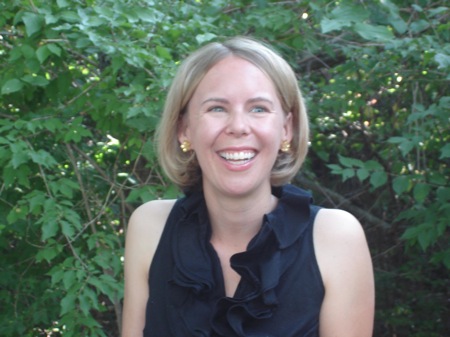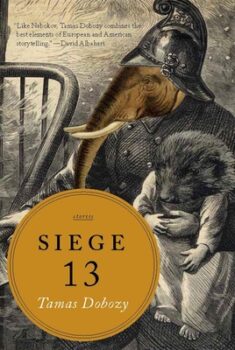Southern books beckon me. When a copy of Mary Stewart Atwell’s debut novel Wild Girls (Simon & Schuster) arrived in late summer, I had every intention of assigning it to one of our fantastic contributors. But the cover caught my eye—a teenager’s black-polished fingers coloring in flames. “I’ll just read the first chapter.” The rest is history.
Atwell joined the FWR Contributors list very early, and for the past four years we’ve had the pleasure of publishing her insightful interviews. We hope to return the favor. Wild Girls stands on the dividing line between adult and YA fiction, and Scribner will market it as an adult novel. It’s easy to see why: Atwell’s teenage narrator Kate Riordan possesses an incendiary mix of bravado and uncertainty that quite simply makes for a compelling read. She attends an exclusive all-girls academy in Swan River, an Appalachian town plagued by a history of murderous “wild girls.” The specter of turning into one of these vengeful wild girls haunts Kate and fuels the tension of the book. Atwell uses witchcraft, legend, herbal lore, and just enough factual evidence to keep the reader—and Kate—guessing about the mysterious series of events that unfold.
Mary Stewart Atwell grew up in the Blue Ridge Mountains of southwest Virginia. She received her BA from Hollins University and her MFA from Washington University in St. Louis, where she is months away from finishing a Ph.D. in literature. Her short fiction has appeared in Epoch, Alaska Quarterly Review, Faultline, and other journals, and in the anthologies Best New American Voices and Best American Mystery Stories. She lives in Missouri with her husband and son.
We conducted this interview over a series of emails in late August.
Interview
Lee Thomas: There’s something I like to think of as “girl fear” in literature. Hester Prynne. Anna Karenina. Ellen Olenska. Cassandra. Wild Girls pushes the type even further—what attracted you to a town plagued by incendiary young women?
Mary Stewart Atwell: I love the idea of “girl fear,” and in a sense it is where I began. In this case, though, it wasn’t so much the societal fear of femininity that I see in The Scarlet Letter, The Age of Innocence, etc., as girls’ fears of themselves and each other. In my mid-twenties, I wrote a novel about friends at a boarding school, and it was kind of terrible—pointless, meandering. I knew I wanted to write about this time in your life when friendships are intense and self-destruction has a certain appeal, but I hadn’t found the right form for it.
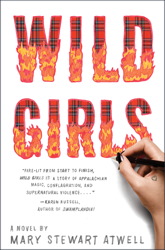 For the spark that led me to the wild girls, I have to thank my husband, Charlie Cline. He’s a filmmaker, and his work often uses genre elements within a realistic framework. When we met, I was way into Cheever, Richard Yates, that whole era, and I thought of genre fiction as sort of a low form of storytelling. I loved how cheerful and unapologetic Charlie was about preferring stories with strong plots, exciting plots. Suddenly I began to notice how many writers I admired were borrowing from genre fiction in a way that gave their narratives a lot of momentum—Aimee Bender, Dan Chaon, Karen Russell. Around the same time I fell in love with the work of William Gay, whose novels and stories bring a mythic dimension to a Southern landscape that is very familiar to me.
For the spark that led me to the wild girls, I have to thank my husband, Charlie Cline. He’s a filmmaker, and his work often uses genre elements within a realistic framework. When we met, I was way into Cheever, Richard Yates, that whole era, and I thought of genre fiction as sort of a low form of storytelling. I loved how cheerful and unapologetic Charlie was about preferring stories with strong plots, exciting plots. Suddenly I began to notice how many writers I admired were borrowing from genre fiction in a way that gave their narratives a lot of momentum—Aimee Bender, Dan Chaon, Karen Russell. Around the same time I fell in love with the work of William Gay, whose novels and stories bring a mythic dimension to a Southern landscape that is very familiar to me.
So I when I began Wild Girls, I knew I wanted to try to become a different sort of writer—more adventuresome, more open to material that went beyond the strictly realistic. At the same time, I was still interested in the subject matter of the last novel and in exploring what it means to be a teenage girl in a world of girls. It was when I brought those two perspectives together that things really started to click.

Responsibility. Agency. Kate Riordan struggles with whether becoming a wild girl is a choice or a curse. Can you talk a bit about this tension in the book?
Kate knows that most of the wild girls come from disadvantaged backgrounds, that they’ve experienced a lot of trauma in their lives. She has some things in common with them, and she’s afraid that those factors might incline her to become one of them. She tends to be a little deterministic in her thinking, but then when someone she knows becomes a wild girl, she has a hard time deciding, “Was this a choice she made, or something that she was pushed into by circumstance?” I think that’s always a hard question to answer about our own actions, and perhaps especially when we’re teenagers, with a pretty limited ability to analyze or put things in context.
Kate’s best-friend-cum-nemesis Willow comes from the wealthy side of Swan River and pretty much takes whatever she wants—Mason Lemons, Kate’s crush, for example. This isn’t some grrl-power homage to female friendship; you show a lot of messiness and back-stabbing.
Well, Kate has two close friends in the book, Willow and Caroline. The relationship with Willow is at center stage a lot of the time, and the reader can see (even when Kate can’t) that there are a lot of problems there—Willow is vain and controlling, and she takes Kate for granted. The friendship with Caroline, though, is very stable and genuine. I think that this is pretty much how it is in the world off the page—some friendships are temporary allegiances based in opportunism, and others are real and stick with us through the years. I wouldn’t want to sentimentalize friendships among girls, but I’m definitely not trying to indict them either. Most of my closest friends now I met when I was between sixteen and twenty, and I feel really lucky that they’re still with me when my life has changed in so many other ways.
Do you have “literary” friendships, a circle of support? What role does the writing community play in your perseverance as a writer?
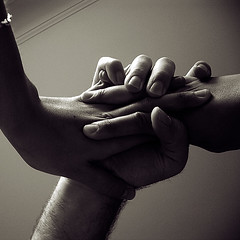 At this point, I think I can say that I’ve been part of some kind of writing community for most of my life. I decided I wanted to be a writer when I was pretty young, and I was lucky enough to have opportunities to take workshops and classes even before college. When I was writing my acknowledgements for Wild Girls, I realized that I’d been calling on writer friends from all parts of my life—one I met at the UVA Young Writers Program after freshman year of high school, one from college, several from grad school. I love having that base of people whose opinions on my work I can trust and learn from, and whose own work I really enjoy and value. I’ve also been able to stay in touch with several beloved teachers from over the years, who have taught me so much not only about the craft of fiction, but about living a good life as a writer. Balancing the work with the demands of family and teaching gets increasingly difficult as I get older, and I feel fortunate to have so many examples in my life of people who have done it well.
At this point, I think I can say that I’ve been part of some kind of writing community for most of my life. I decided I wanted to be a writer when I was pretty young, and I was lucky enough to have opportunities to take workshops and classes even before college. When I was writing my acknowledgements for Wild Girls, I realized that I’d been calling on writer friends from all parts of my life—one I met at the UVA Young Writers Program after freshman year of high school, one from college, several from grad school. I love having that base of people whose opinions on my work I can trust and learn from, and whose own work I really enjoy and value. I’ve also been able to stay in touch with several beloved teachers from over the years, who have taught me so much not only about the craft of fiction, but about living a good life as a writer. Balancing the work with the demands of family and teaching gets increasingly difficult as I get older, and I feel fortunate to have so many examples in my life of people who have done it well.
In J. Robert Lennon’s recent essay “How to Write a Bad Review,” there was a line I loved: “the literary world is basically a small city. We could maybe all comfortably occupy Madison, Wisc.” Now that so much of the literary world has moved online, I think we’re all realizing how interconnected we really are, and of course that elbow-rubbing closeness has its disadvantages too. Still, to me it’s very comforting to feel that I’m part of a small city of people who care passionately about the same things that I do.
Why do you think society has linked teenage girls and witchcraft/prophecy/the occult for so long (see: Cassandra, 800 B.C.; Salem, et al)? Is there something special about their state?
I was obsessed with the Salem witch trials in middle school, and I definitely feel that female adolescence has a spooky dimension to it—for some girls, anyway. Kate thinks (and I’d tend to agree with her) that it has a lot to do with powerlessness. Teenage girls are pseudo-adults in some ways, but they’re also the least powerful people in society, and rage at that powerless state can manifest in all sorts of ways. In real life, we probably usually see it as self-destructive behavior, but it can also take the form of a sort of fantasy of dominance. You could say that that’s what happened in Salem—those girls went from being totally disregarded to having the whole village’s lives in their hands—and it’s what happens in this book too. Not that I thought in these terms while I was writing, of course—I think if I’d thought too much about what the wild girls meant metaphorically, I probably wouldn’t have been able to write about them at all.

Swan River has a strong town-and-gown dynamic with the Swan River Academy and the hardship-bearing locals without many prospects or avenues out—or in some cases even a desire to leave. Does this split boil down to the inability of each side to understand the other?
I think that’s true—they don’t understand each other, and they don’t really have any desire to. My hometown isn’t much like Swan River in most ways, but it’s a college town in the Blue Ridge Mountains, and growing up I was very aware of whose parents taught at the university and whose didn’t. Looking back, I don’t think I came up with that on my own—I think there was a definite understanding among the teachers and the parents that some kids were going to go to college, move out of state, have careers, and others didn’t have a prayer of doing any of those things. At the time, I was like Kate—I thought I deserved better than my hometown, that I should have been born in Brooklyn, or Berkeley, or London. I probably had a particularly bad attitude, but I also think that the tension between the going-somewheres and the not-going-anywheres was just part of the place.
When people think of the Appalachians, a lot of them probably think of JFK and the anti-poverty programs of the sixties. The sad thing is that for big parts of the region, things haven’t gotten a whole lot better. My husband is from a small town in West Virginia, and all the businesses have moved out, all the industry—you can feel the hopelessness in the air. To me the Blue Ridge is the most beautiful place in on earth, but I think that a lot of people there feel that the world hasn’t played fair by them, and maybe they’re right. In describing Swan River, I drew on both these things—the beauty of the place, and also the sadness that sometimes seems like a natural part of the landscape.
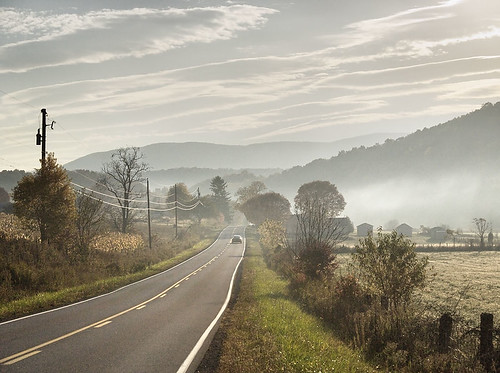
Scribner is marketing this to a mainstream fiction audience, but it could have easily been labeled YA—is this a decision you were involved in? How do you think about your audience—and how to reach it—once a book is finished?
This probably just speaks to my ignorance of the publishing industry, but it didn’t occur to me that the novel could be YA until I’d been working on it for about two and a half years. Then I read a draft of Erin Saldin’s terrific YA novel The Girls of No Return, which has a boarding school setting and a lot of smart, interesting teenage characters. Erin had written her book as YA and I’d been assuming that mine was literary fiction, but then I started to wonder if I’d had it wrong. Over the next couple of summers, I got to read pieces of the novel to my wonderful high school students at Interlochen Arts Camp, and I was really gratified by their reaction—they seemed to get it at once, and I loved being able to communicate with that audience.
When I finally got to the stage of querying agents, some of them felt strongly that it was YA. When it went out to editors, though, it was the opposite—every one I spoke with thought it should be published as adult fiction. I do think that was the right choice. To me, the fact that Kate tells the story retrospectively, from an adult point of view, is very important to how the reader processes the narrative. I’m less interested in what it’s like to be a teenager than what it’s like to have been one—what those experiences look like from the other side of thirty. At the same time, I hope very much that Wild Girls will appeal to a wide audience, age-wise.
Are you working on something new? If so, care to discuss?
Caginess is one of my least favorite qualities, but I think I might have to be a little bit cagey about this. I wrote two unpublished novels before Wild Girls, and I hate the thought of going through that again—spending years and years on a project and then having to abandon it in despair. I have this idea that maybe if I don’t talk too much about the novel I’m working on now, maybe I’ll get to keep it in the form that exists in my head. But I don’t think I’m jeopardizing that if I say that it’s called The Wandering House, and it’s about mothers and daughters. It involves a lot more research and advance planning than I did for Wild Girls, and I’m having fun with that.
Further Links & Resources
- Watch the book trailer for Wild Girls, complete with slow-driving and crazy-time in the woods:
Wild Girls by Mary Stewart Atwell Book Trailer from Charlie Cline on Vimeo.
- Read Mary Stewart Atwell’s interviews with Lydia Davis, Mark McGurl, Andrew Porter, and Kevin Brockmeier.
- Follow Atwell on Twitter: @MStewartAtwell

